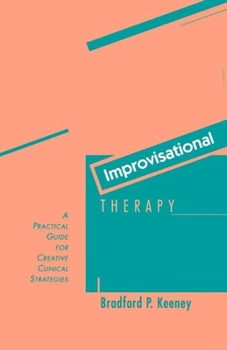Improvisational Therapy: A Practical Guide for Creative Clinical Strategies
Select Format
Select Condition 
Book Overview
In this unusual volume, Bradford Keeney depicts psychotherapy as a performing art. Emphasizing the advantages of improvising one's own therapeutic style, he presents a host of tried-and-true strategic interventions, a short course on brief intervention design, a way of "scoring" conversations with clients much like one would score music, a collection of therapeutic moves, and chapters on creating one's own clinical design.
Format:Paperback
Language:English
ISBN:089862486X
ISBN13:9780898624861
Release Date:February 1990
Publisher:Guilford Publications
Length:123 Pages
Weight:0.46 lbs.
Dimensions:0.3" x 5.5" x 8.5"
Customer Reviews
2 ratings
Aesthetics - the road ahead
Published by Thriftbooks.com User , 26 years ago
This volume represents a logical outflow of Keeney's first publication: "The aesthetics of change". It challenges the reader to use whatever she's got as personal resources in the creation of a truly personal therapeutic style.Some echoes of his subsequent publications are also found in the re-framing of the work of other therapists. "Mind in therapy" is a clear precursor of the thought of this book.Improvisational Therapy challenges the reader to use her own creativity, without relying on the "recipes" of others. Keeney contextualizes therapy as performing art, not completely tongue in cheek.
Practical, and essential for the clinician.
Published by Thriftbooks.com User , 27 years ago
Dr. Keeney presents a wealth of information in a small volume. Little time is wasted on theory and the question "Why?". Most of the book is devoted to explicit descriptions of techniques that can be powerful techniques of change. In the first third of the book, Dr. Keeney describes a number of techniques from the MRI, forerunners of many of today's "power therapies". In the second third, Keeney describes a method that makes use of an art gallery as a metaphor for conducting psychotherapy. His use of the idea of "frames' is especially useful given that Keeney maps out many of the possible ways a client's "frames of reference" can be influenced for change. In the final third, Dr. Keeney presents a self-development exercise useful to the begining and the experienced therapist. Through the use of open-ended questions, Keeney guides the reader through a process that can enhance self-awareness and point to areas of professional growth. In conclusion, I would recommend this slim volume to any therapist who is thirsting for practical and useful techniques.





